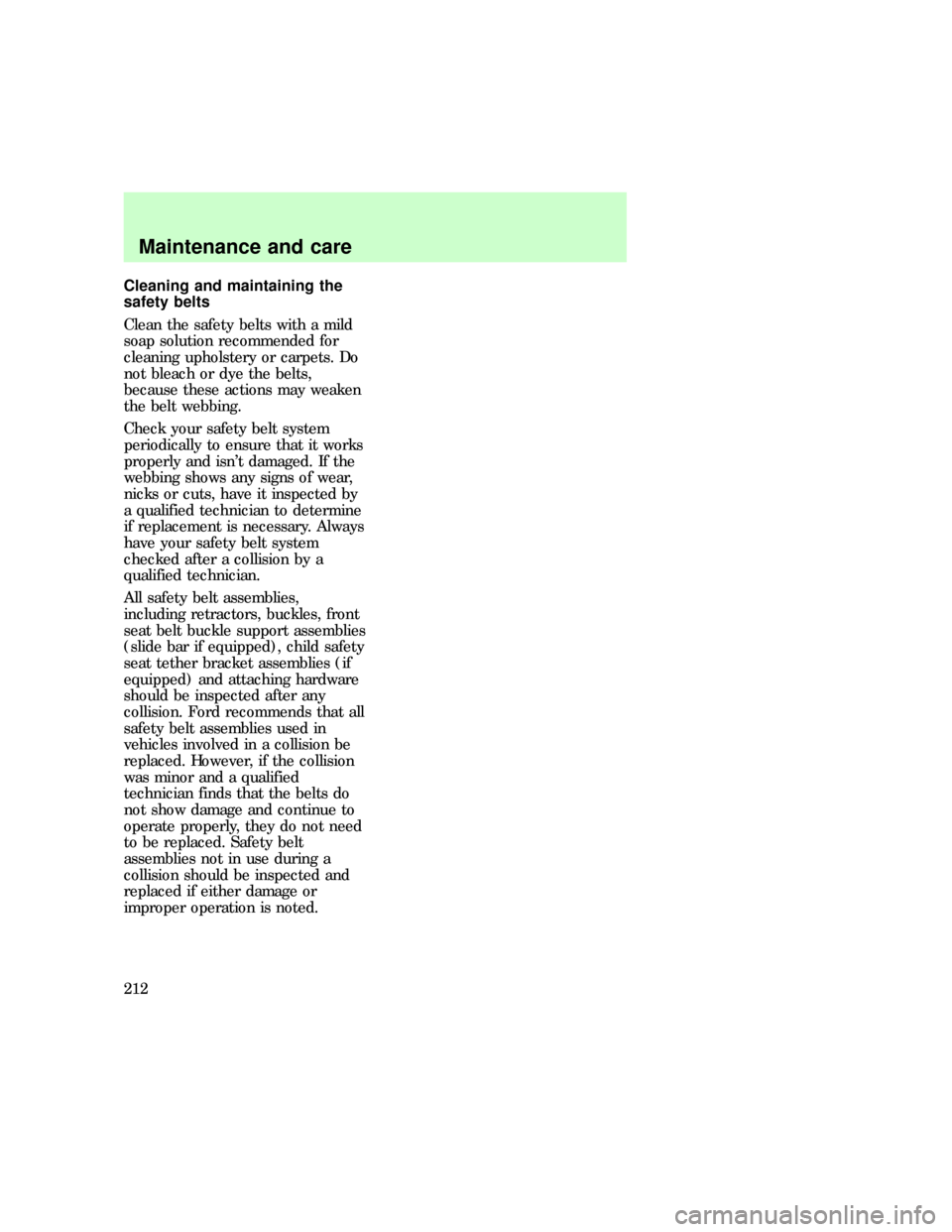Page 122 of 224

LOADING YOUR VEHICLE
It is extremely dangerous
to ride in a cargo area,
inside or outside of a vehicle. In
a collision, people riding in these
areas are more likely to be
seriously injured or killed. Do not
allow people to ride in any area
of your vehicle that is not
equipped with seats and safety
belts. Be sure everyone in your
vehicle is in a seat and using a
safety belt properly.
Before loading your vehicle,
familiarize yourself with the
following terms:
²Base curb weight :Weight of the
vehicle including any standard
equipment, fluids, lubricants,
etc. It does not include
passengers or aftermarket
equipment.
²Payload :Combined maximum
allowable weight of passengers,
cargo and optional equipment.
²GVW (Gross Vehicle Weight) Ð
Base curb weight plus the
payload weight. The GVW is not
a limit or a specification.
²GVWR (Gross Vehicle Weight
Rating) :Maximum total weight
of the base vehicle, passengers,
optional equipment and cargo.
The GVWR is specific to each
vehicle and is listed on the
Safety Compliance Certification
Label on the driver's door pillar.
²GAWR (Gross Axle Weight
Driving
123
Page 153 of 224
WRECKER TOWING
If towing is necessary, it is
recommended that your vehicle be
towed with wheel lift or flatbed
equipment. Do not tow with
slingbelt equipment. Ford Motor
Company has not developed or
approved a slingbelt towing
procedure.
On 4x2 vehicles, it is acceptable to
tow the vehicle with the front
wheels on the ground and the rear
wheels off the ground.
On vehicles equipped with
Air Suspension, turn OFF
the Air Suspension switch prior
to jacking, hoisting or towing
your vehicle.
Roadside emergencies
154
Page 185 of 224
When replacing full size
tires, never mix radial,
bias-belted, or bias-type tires.
Use only the tire sizes that are
listed on the tire pressure decal.
Make sure that all tires are the
same size, speed rating, and
load-carrying capacity. Use only
the tire combinations
recommended on the decal. If
you do not follow these
precautions, your vehicle may
not drive properly and safely.
Make sure that all
replacement tires are of
the same size, type, load-carrying
capacity and tread design (e.g.,
ªAll Terrainº, etc.), as originally
offered by Ford.
Do not replace your tires
with ªhigh performanceª
tires or larger size tires.
Failure to follow these
precautions may adversely
affect the handling of the vehicle
and make it easier to lose control
and roll over.
Your vehicle requires the use of
the following tire types:
²A/S BSW P255/70R 16
²A/T OWL P255/70R 16
²A/T OWL P265/70R 17
Maintenance and care
186
Page 210 of 224
Cleaning the instrument panel
Clean instrument panel with a
damp cloth, then dry with a dry
cloth.
Any cleaner or polish that
increases the gloss of the upper
portion of the instrument panel
should be avoided. The dull finish
in this area is to help protect the
driver from undesirable windshield
reflection.
Cleaning the interior fabric
Remove dust and loose dirt with a
whisk broom or a vacuum cleaner.
Remove fresh spots immediately.
Follow the directions that come
with the cleaner.
Cleaning leather seats (if
equipped)
For routine cleaning, wipe the
surface with a soft, damp cloth.
For more thorough cleaning, wipe
the surface with a leather and
vinyl cleaner or a mild soap.
com_int_fabric_cleaning.01
com_leather_seats_cleaning.01
exd_cleaning_safety_belts
Maintenance and care
211
Page 211 of 224

Cleaning and maintaining the
safety belts
Clean the safety belts with a mild
soap solution recommended for
cleaning upholstery or carpets. Do
not bleach or dye the belts,
because these actions may weaken
the belt webbing.
Check your safety belt system
periodically to ensure that it works
properly and isn't damaged. If the
webbing shows any signs of wear,
nicks or cuts, have it inspected by
a qualified technician to determine
if replacement is necessary. Always
have your safety belt system
checked after a collision by a
qualified technician.
All safety belt assemblies,
including retractors, buckles, front
seat belt buckle support assemblies
(slide bar if equipped), child safety
seat tether bracket assemblies (if
equipped) and attaching hardware
should be inspected after any
collision. Ford recommends that all
safety belt assemblies used in
vehicles involved in a collision be
replaced. However, if the collision
was minor and a qualified
technician finds that the belts do
not show damage and continue to
operate properly, they do not need
to be replaced. Safety belt
assemblies not in use during a
collision should be inspected and
replaced if either damage or
improper operation is noted.
Maintenance and care
212
Page 222 of 224

Idle
relearning ................................178
Ignition .........................................68
Instrument panel ........................20
Jack ..............................................66
Jump-starting your vehicle 151,152
attaching cables ......................152
disconnecting cables ..............153
Lamps
interior lamps ...........................54
parking lamps .........................201
Lights, warning and indicator
anti-lock brakes (ABS) ............12
brake ..........................................10
charging system ..........................9
high beam .................................12
safety belt ............................10,86
Message center ...........................17
english/metric button ...............18
low fuel level ........................18,19
Motorcraft parts ........................213
Odometer .....................................17
Overdrive .....................................48
Overdrive lockout button ...........11
Overhead console
compass/temperature display ..50
Power features
door locks ..................................60
windows ...............................58,59
Power steering
fluid, checking and adding ....170
Rear console ................................63
Rear window
wiper ..........................................46
Relays ........................................135
Remote entry system
locking/unlocking doors ...........69
panic alarm ...............................69
replacement/additional
transmitters ...............................70
replacing the batteries .............70
Reporting safety defects ..........221Safety restraints
extension assembly ..................85
for children ...............................91
lap and shoulder belts ........82,83
proper use ............................80,81
Safety seats for children ............94
attaching with tether straps ....99
automatic locking mode
(retractor) ............................95,98
Seats ............................................72
bench (60-40 split) .............72,73
lumbar support .........................73
power seat recliner/lumbar ......74
rear flip fold seat ......................75
rear seat access ........................74
third row seat .................76,77,79
Servicing your vehicle ..............155
precautions when servicing ...155
Special notice
utility-type vehicles ....................2
Speed control ..............................41
accelerating ...............................42
resetting ....................................43
resuming a set speed ...............43
turning off .................................41
Speedometer ...............................14
Starting your vehicle ................100
preparing to start your
vehicle .....................................101
starting a warm engine ..........103
Steering, power .........................109
Steering wheel ............................40
Tachometer
mechanical cluster ...................15
Temperature control (see
Climate control) .....................28,29
Tires
changing ..................................144
inspection and maintenance ..182
tire grades ...............................182
treadwear ................................182
Traction-lok rear axle ...............111
Index
223
Page 223 of 224

Trailer towing
calculating maximum trailer
weight ......................................127
Transfer case (see Differential
fluid) ...................................175,176
Transmission ......................114,172
Transmission control switch ......49
Trip odometer .............................17
Turn signal ..................................47
indicator lights ..........................12
Vehicle dimensions ...................218
Vehicle headlamp aiming
device (VHAD) .........................206
Ventilating your vehicle ...........105
Voltmeter (see Battery voltage
gauge) ..........................................16Warning chimes
headlamps on ............................14
key in ignition ...........................14
safety belt .................................13
Warning lights (see Lights) .8,144,
145
Windows
accessory delay .........................59
Windshield washer fluid and
wipers ........................................179
checking and adding fluid .....164
operation ..............................44,45
Wrecker towing .........................154
Index
224